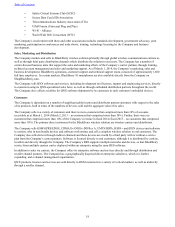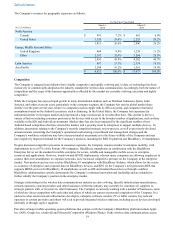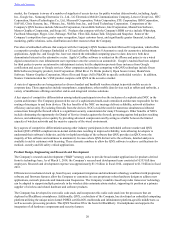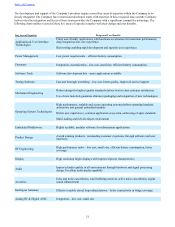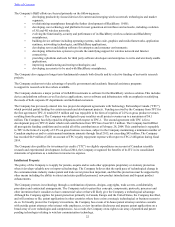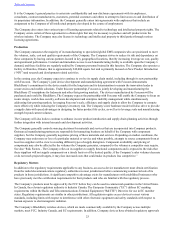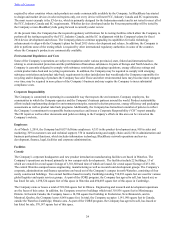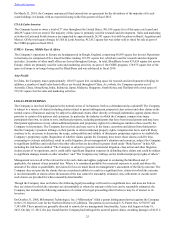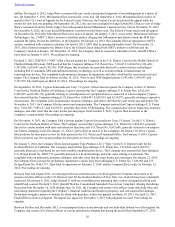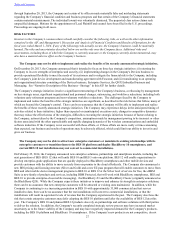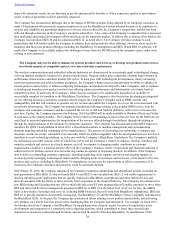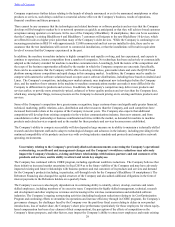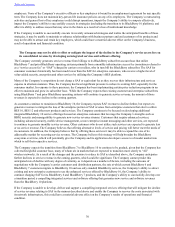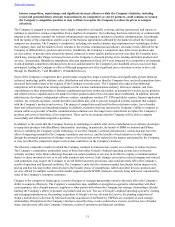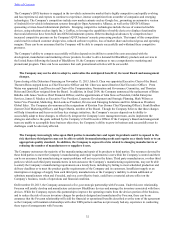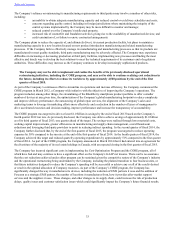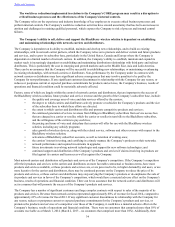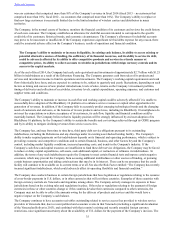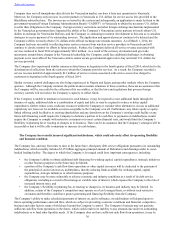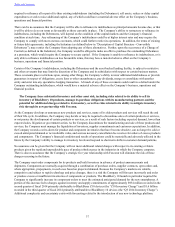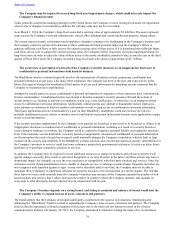Blackberry 2014 Annual Report Download - page 36
Download and view the complete annual report
Please find page 36 of the 2014 Blackberry annual report below. You can navigate through the pages in the report by either clicking on the pages listed below, or by using the keyword search tool below to find specific information within the annual report.
28
align with customers' needs, are not launched as per the announced the timeline or if they experience quality or performance
issues, results of operations could be materially impacted.
The Company has encountered challenges due to the impact of BYOD strategies being adopted by its enterprise customers, as
many IT departments that previously required employees to use the BlackBerry wireless solution because of its emphasis on
security and reliability are permitting employees to choose devices offered by the Company’s competitors, and this has been
reflected through a decrease in the Company’s enterprise subscribers. Also, some of the Company’s competitors have increased
their marketing and product development efforts and focus on the enterprise market. To address this evolution of the market, the
Company has introduced BES 10 and has announced BES 12, as noted above. The Company will also continue to seek
partnerships that will further enable the Company to enhance these and potentially other offerings. However, there can be no
assurance that these new product offerings, including the BlackBerry 10 smartphones and BES 10 and BES 12 software, will
enable the Company to successfully address the challenges it faces from the BYOD trend in the enterprise space, either with
existing or new customers.
The Company may not be able to enhance its current products and services, or develop new products and services,
in a timely manner, at competitive prices, or to meet customer requirements.
The wireless communications and embedded software industries are characterized by increasingly rapid technological change,
evolving industry standards, frequent new product introductions, frequent market price reductions, constant improvements in
performance characteristics and short product life cycles. To keep pace with technological developments, satisfy increasing
customer requirements and achieve product acceptance, the Company’s future success depends upon its ability to enhance its
current products and services, to address competing technologies and products developed by other companies, and to continue
to develop and introduce new products and services offering enhanced performance and functionality on a timely basis at
competitive prices. In particular, the Company’s future success continues to be significantly dependent on its ability to
successfully complete its transition to the BlackBerry 10 platform. The Company is also focused on developing an integrated
service offering focused on enterprise customers that leverages the Company’s strengths such as BBM, security and
manageability and that will continue to generate service revenue and enable the Company to recover the costs associated with
its network infrastructure. The Company has announced additional offerings relating to the popular BBM service, both for
enterprise and consumer customers, and has expanded the service to iOS and Android platforms, with a view to increase the
user base. Further, the Company announced in February 2014 that BBM will be made available to Windows Phone and Nokia
X customers in the coming months. The Company believes that a corresponding increase in the user base for the BBM service
could lead to increased opportunities for monetization of the services offered through the platform, through advertising or
through the implementation of the solutions by enterprise customers. The Company has also announced that QNX expects to
introduce the QNX Cloud platform in fiscal 2015, a cloud-based machine to machine management and communication
platform targeting embedded computing device manufacturers. The process of developing new technology is complex and
uncertain, and involves time, substantial costs and risks, which are further magnified when the development process involves a
transition to a new technology platform, as is the case with the Company’s BlackBerry 10 platform. The Company’s inability,
for technological or other reasons, some of which may be beyond the Company’s control, to enhance, develop, introduce and
monetize products and services in a timely manner, or at all, in response to changing market conditions or customer
requirements, could have a material adverse effect on the Company’s business, results of operations and financial condition or
could result in its products and services not achieving market acceptance or becoming obsolete. In addition, if the Company
fails to deliver a compelling customer experience, including marketing, sales support, activation and ongoing support, or
accurately predict emerging technological trends and the changing needs of customers and end users, or the features of its new
products and services, including its BlackBerry 10 smartphones, do not meet the expectations or achieve acceptance of its
customers, the Company’s business and prospects could be materially harmed.
On February 25, 2014, the Company announced new enterprise solutions, partnerships and smartphone models, including the
next generation of BES (BES 12) that will unify BES 10 and BES 5 onto one platform. BES 12 will enable organizations to
develop enterprise-grade applications that are quickly deployed to BlackBerry smartphones and other mobile devices and
provide customers with the ability to move securely from on-premise to the cloud effortlessly. The Company also announced a
new BES pricing and licensing structure (Silver and Gold) and a new EZ pass program that will enable customers to move from
BES and other mobile device management programs to BES 10 or BES 12 at the Silver level of service for free, the eBBM
Suite (a new family of products and services, including BBM Protected, that will work with BlackBerry smartphones, BES and
BES 10 to provide enterprise-class mobile messaging), the BlackBerry Z3 and the BlackBerry Classic (originally announced as
the BlackBerry Q20). In the past, the Company has encountered delays relating to new product introductions, and delivering
new products on a timely basis has proven more challenging than the Company had anticipated. For example, in fiscal 2013,
the introduction of the Company’s first BlackBerry 10 smartphones were delayed, in part, because of complexities in the
development and integration of a completely new technology platform, which contributed to lower than expected unit
shipments as customers worked through inventory and awaited the launch of the new BlackBerry 10 smartphones. If the
Table of Contents


